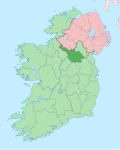History
In medieval times Furnaceland was owned by the McGovern Clan and formed part of a ballybetagh spelled (variously) Aghycloony, Aghcloone, Nacloone, Naclone and Noclone (Irish derived place name Áth Chluain, meaning the "Ford of the Meadow"). The 1609 Baronial Map depicts the ballybetagh as Naclone. [3] [4]
In the Plantation of Ulster by grant dated 26 June 1615, King James VI and I granted, inter alia, The precinct or parcel of Nacloone otherwise Aghcloone to Sir George Graeme and Sir Richard Graeme to form part of the Manor of Greame. [5] A history of Richard and George Graham is viewable online. [6] The Grahams took part in the Irish Rebellion of 1641 and after the war their lands were confiscated under the Act for the Settlement of Ireland 1652.
The 1658 Down Survey map depicts the townland as Enean. [7]
In 1766 Furnaceland was one of the first Methodist communities founded in County Cavan. A Methodist Pioneer: or the Life and Labours of John Smith by Charles Henry Crookshank (1885) states on page 196: In 1766, however, in connection with the zealous and faithful labours of John Smith, a large number of Societies were formed, including those at Mullalougher, Killashandra, Bawnboy, Belturbet, Cavanagh, Ballyconnell, Swanlinbar, Furnaceland and Gortnaleg. [8] Crookshank describes how Smith felt a prompting to turn aside into the bridleway to Furnaceland, only to hear the voice of Satan shouting in his ear to turn back. Smith went on, and many were converted. [9]
In the Fermanagh Poll of Electors 1788 there was one Furnaceland resident, Thomas McCleland, who was entitled to vote as he owned land in Cleenaghan townland in Magheracross parish. [10]
The 1821 Census of Ireland spells the name as "Mearaveny or Furnish Land and Macraveny and Macreveny and Macreeveny" and states, "contains 148 acres of arable & pasture land & 15 acres of bog- there is also a church & burial ground on same". [11] [12] [13] [14] [15]
The 1825 Tithe Applotment Books spell the name as Furnaceland and Maugheraveey. [16] [17]
The 1836 Ordnance Survey Namebooks state: In this land, the iron-works were carried on. There is the ruins of an iron foundary which has not been used these many years.
The Furnaceland Valuation Office Field books are available for 1838-1840. [18]
Griffith's Valuation lists fifty-five landholders in the townland. [19]
Folklore from Furnaceland is found in the 1938 Dúchas collection. [20]
This page is based on this
Wikipedia article Text is available under the
CC BY-SA 4.0 license; additional terms may apply.
Images, videos and audio are available under their respective licenses.





